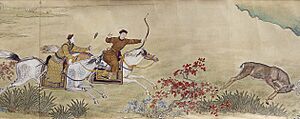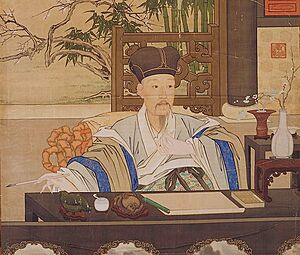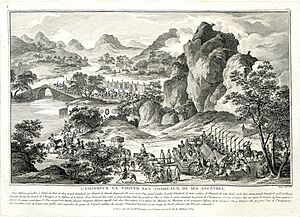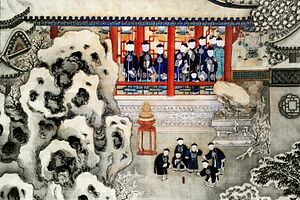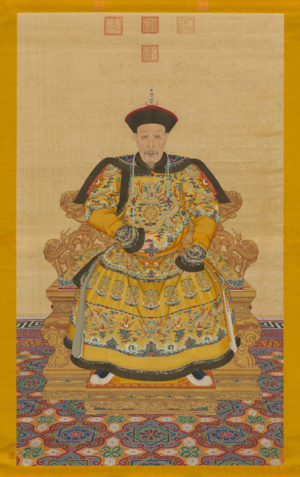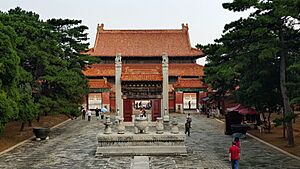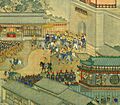Qianlong Emperor facts for kids
Quick facts for kids Qianlong Emperor |
|||||||||||||||||
|---|---|---|---|---|---|---|---|---|---|---|---|---|---|---|---|---|---|
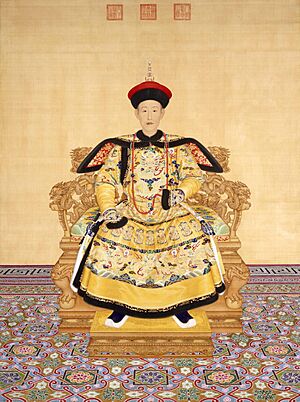
Portrait by Giuseppe Castiglione
|
|||||||||||||||||
| Emperor of the Qing dynasty | |||||||||||||||||
| Reign | 18 October 1735 – 9 February 1796 | ||||||||||||||||
| Predecessor | Yongzheng Emperor | ||||||||||||||||
| Successor | Jiaqing Emperor | ||||||||||||||||
| Emperor Emeritus of the Qing dynasty | |||||||||||||||||
| Tenure | 9 February 1796 – 7 February 1799 | ||||||||||||||||
| Prince Bao of the First Rank | |||||||||||||||||
| Tenure | 1733–1735 | ||||||||||||||||
| Born | 25 September 1711 (康熙五十年 八月 十三日) Prince Yong's Mansion, Beijing |
||||||||||||||||
| Died | 7 February 1799 (aged 87) (嘉慶四年 正月 三日) Forbidden City, Beijing |
||||||||||||||||
| Burial | Yu Mausoleum, Eastern Qing tombs | ||||||||||||||||
| Spouse |
Empress Xiaoxianchun
(m. 1727; died 1748)Empress Nara
(m. 1734; died 1766)Empress Xiaoyichun
(m. 1745; died 1775) |
||||||||||||||||
| Issue |
|
||||||||||||||||
|
|||||||||||||||||
| House | Aisin-Gioro | ||||||||||||||||
| Dynasty | Qing | ||||||||||||||||
| Father | Yongzheng Emperor | ||||||||||||||||
| Mother | Empress Xiaoshengxian | ||||||||||||||||
| Religion | Vajrayana Buddhism | ||||||||||||||||
| Seal | 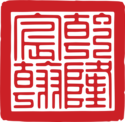 |
||||||||||||||||
| Qianlong Emperor | |||||||||||||||||||
|---|---|---|---|---|---|---|---|---|---|---|---|---|---|---|---|---|---|---|---|
| Traditional Chinese | 乾隆帝 | ||||||||||||||||||
| Simplified Chinese | 乾隆帝 | ||||||||||||||||||
|
|||||||||||||||||||
The Qianlong Emperor (born 25 September 1711, died 7 February 1799) was an important ruler in Chinese history. His personal name was Hongli. He was the fifth emperor of the Qing dynasty. He ruled China from 1735 until he stepped down in 1796.
Even after giving up his throne, he still held power until his death in 1799. This made him one of the longest-reigning monarchs ever. He was also one of the longest-lived emperors.
Qianlong was the fourth son of the Yongzheng Emperor. He became emperor in 1735. He was a very successful military leader. He led many campaigns into places like Inner Asia, Burma, and Vietnam. He also put down rebellions in China.
He was a big supporter of the arts and a writer. He helped create the Complete Library of the Four Treasuries. This was the largest collection of Chinese history ever made. His reign was a time of great power and wealth for the Qing dynasty.
In 1796, Qianlong gave up his throne after 60 years. He did this to show respect for his grandfather, the Kangxi Emperor. Kangxi had ruled for 61 years. Qianlong did not want to rule longer than him. His son, the Jiaqing Emperor, took the throne. But Qianlong still held real power as Emperor Emeritus until he died in 1799. He was 87 years old.
The Qianlong era was the peak of the Qing dynasty. The empire had the largest population and economy in the world. It also reached its biggest size during his rule. However, many wars weakened the military. There was also corruption in his court. These problems slowly led to the decline of the Qing empire.
Contents
Early Life of Emperor Qianlong
Hongli was the fourth son of the Yongzheng Emperor. His mother was Noble Consort Xi. Both his grandfather, the Kangxi Emperor, and his father loved Hongli very much. Some historians believe Kangxi chose Yongzheng as his successor because Hongli was his favorite grandson. Kangxi felt Hongli was very similar to him.
As a teenager, Hongli was good at martial arts. He was also skilled in writing and literature.
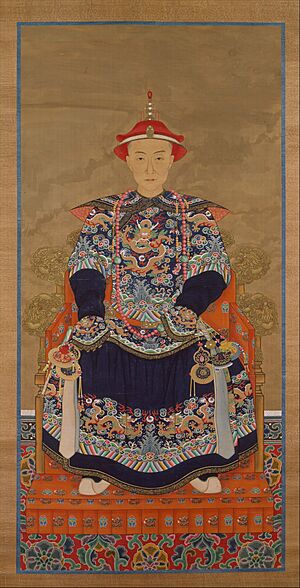
After his father became emperor in 1722, Hongli was made a first-rank prince. His title was "Prince Bao of the First Rank". Hongli had to compete with his older half-brother, Hongshi, for the throne. Many officials thought his father favored Hongli. Hongli went on trips to the south of China. He was a good negotiator and enforcer. He also acted as the main regent when his father was away.
Becoming Emperor: Qianlong's Accession
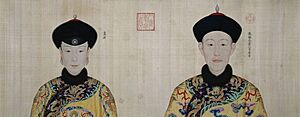
Hongli becoming emperor was expected. He was the favorite grandson of the Kangxi Emperor. He was also the favorite son of the Yongzheng Emperor. While still a prince, Hongli was given important tasks. He was also included in court discussions about military plans.
To prevent fights over who would rule next, the Yongzheng Emperor wrote his chosen successor's name on paper. He put it in a sealed box behind a tablet above the throne. This box was only to be opened after the emperor's death.
When the Yongzheng Emperor died suddenly in 1735, the will was read. Hongli then became the new emperor. He chose the era name "Qianlong," which means "Lasting Eminence."
In 1739, a prince named Hongxi tried to overthrow Qianlong. Hongxi was the son of Kangxi's former crown prince. He planned a coup with five other princes. They wanted to attack during an imperial hunt. But the plot was discovered, and the princes were arrested. The main plotters were jailed. Others lost their titles.
Years later, in 1778, Qianlong restored the original names of some princes involved. He allowed their families to be in the imperial records. However, he did not give back their titles.
Expanding the Empire: Frontier Wars
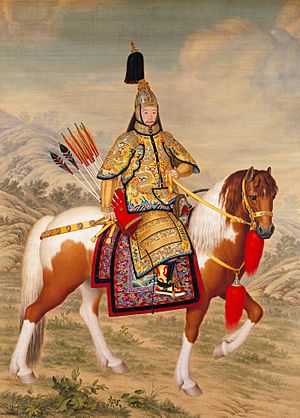
The Qianlong Emperor was a strong military leader. Soon after he became emperor, he sent armies to stop the Miao rebellion. His later military campaigns made the Qing Empire much larger. This happened because the Qing army was powerful. Also, the people in Inner Asia were not united.
Under Qianlong, the Dzungar Khanate became part of the Qing Empire. It was renamed Xinjiang. The Dzungars were a group of Western Mongol tribes. After their final defeat, the Qianlong Emperor ordered the Dzungar genocide. Many Dzungars were killed by disease or the Qing army. Others fled to Russia or Kazakh tribes. Historians say this was a policy of massacre.
Qing armies also went into Tibet. They made sure the Dalai Lama ruled Tibet. A Qing official and soldiers stayed there to keep Qing control. Campaigns against Nepalese and Gurkhas also happened.
The Sino-Burmese War was not successful for China. Qianlong thought it would be an easy win. He sent only the Green Standard Army. But the Burmese forces, who were experienced in battle, defeated the first two invasions. The third invasion by elite Manchu Bannermen almost reached the Burmese capital. However, the Manchu soldiers struggled with the tropical weather and diseases. They had heavy losses.
The fourth and largest invasion got stuck at the border. A truce was made in December 1769. China kept many soldiers at the border for ten years. They also banned trade for twenty years. When Burma and China started talking again in 1790, the Qing government said it was a victory.
The situation in Vietnam also went badly. In 1787, the last ruler of Vietnam's Lê dynasty asked Qianlong for help. Qianlong sent a large army to Vietnam. They took the capital, Thăng Long. But a few months later, the Qing army was defeated. This happened because of a surprise attack during Tết (Vietnamese New Year). The Qing Empire stopped supporting the Lê ruler. They did not get involved in Vietnam again for 90 years.
Despite these problems, Qianlong's military actions nearly doubled the size of the Qing Empire. They brought many non-Han peoples under Qing rule. These included Uyghurs, Kazakhs, and Mongols. However, these wars were very expensive. They used almost all the money in the Imperial Treasury.
By the end of Qianlong's reign, the Qing army was weaker. Soldiers became less disciplined. This led to problems like the White Lotus Rebellion. This rebellion started late in Qianlong's rule and continued into his successor's time.
Cultural Achievements and Patronage
The Qianlong Emperor cared deeply about culture. He wanted to preserve Manchu traditions. He believed this was important for the strength of his dynasty. He ordered the creation of Manchu family histories and ritual books. He also ordered the Shamanic Code to be written down.
To show his connection to Buddhist beliefs, he had a replica of the Tibetan Potala Palace built. This was at his summer palace in Chengde. He also had a sacred painting, a thangka, made of himself as Manjushri, the Bodhisattva of Wisdom.
Qianlong was also a poet and writer. He published many collections of his writings. These included over 40,000 poems and 1,300 prose texts. This makes him one of the most prolific writers in history.
He was a major supporter of Confucian culture. He loved collecting art. He gathered many of China's great private art collections. He sometimes pressured wealthy officials to give him precious objects. He would say a painting would be safe from theft only in the Forbidden City.
His art collection was a big part of his life. He took landscape paintings on his travels to compare them with real places. He also wrote poems on the paintings in his collection. This showed his role as emperor. He also used some artworks like a diary, writing private notes on them over time.
Most of the thousands of jade items in the imperial collection are from his reign. He also collected ancient bronzes, mirrors, and seals. Pottery, ceramics, and other arts also thrived. Many items from his collection are now in museums like the Percival David Foundation of Chinese Art in London.
One of his biggest projects was the Complete Library of the Four Treasuries. This was a huge collection of Chinese philosophy, history, and literature. It had 36,000 volumes and about 3,450 complete works. It took 15,000 copyists to create. This project saved many books. But it was also used to find and remove works that were against the Qing dynasty.
Burning and Changing Books
Some 2,300 works were completely removed. Another 350 were partly removed. The goal was to destroy writings that were anti-Qing or rebellious. Also, books that insulted earlier "barbarian" dynasties or discussed defense issues were targeted.
During the ten years it took to complete the Complete Library, 3,100 titles were burned or banned. Many books that were included were changed. Books from the Ming dynasty suffered the most damage.
The authorities would check every word and sentence. If they thought words were disrespectful to the rulers, people could be punished. During Qianlong's time, there were 53 cases of Literary Inquisition. Some people were executed.
Languages and Culture
As a child, Qianlong learned Manchu, Chinese, and Mongolian. He also learned some Tibetan and Chagatai (an old Turkic language). He wanted to keep the Manchu language strong. He said it was the "keystone for Manchus."
He ordered new Manchu dictionaries to be made. He also had the Buddhist canon translated into Manchu. He tried to remove Chinese loanwords from Manchu.
Palaces and Architecture
The Qianlong Emperor loved building. He expanded the Garden of Perfect Brightness (Yuanmingyuan) near Beijing. This palace was originally built by his father. He added two new villas to it. The Old Summer Palace eventually covered 860 acres. This was five times larger than the Forbidden City.
To celebrate his mother's 60th birthday, he improved the Garden of Clear Ripples (Qingyiyuan). He had a lake dredged and named it Kunming Lake. He also renovated a villa there.
Qianlong also expanded the imperial summer palace in Rehe Province. This palace was beyond the Great Wall. Rehe became like a third capital. Qianlong met with Mongol nobles there. He also spent time at the Mulan hunting grounds. He held the imperial hunt there every year.
European Style Buildings
For the Old Summer Palace, Qianlong hired Italian Jesuit Giuseppe Castiglione. He wanted Western-style buildings, called Xiyang Lou. He also hired French Jesuit Michel Benoist to design fountains and waterworks. These were for the imperial family's enjoyment. Other European artists also worked for the emperor.
Other Buildings
During Qianlong's reign, the Emin Minaret was built in Turpan. It honored Emin Khoja, a Uyghur leader. He had helped the Qing fight the Dzungars.
Later Years and Challenges
In his later years, Qianlong became very powerful and confident. He started to trust corrupt officials like Heshen. Heshen became the most powerful minister. He handled the daily running of the country. The emperor spent his time on arts and luxuries.
When Heshen was later executed, his personal wealth was huge. It was more than the Qing Empire's treasury. This showed how much corruption there was.
Qianlong started his reign with a large amount of money in the treasury. At its peak around 1775, the treasury had a record amount of silver. However, many things cost a lot of money. These included corruption, trips to the south, huge palace constructions, and many wars. These expenses, along with his old age, led to the start of the Qing Empire's decline.
Meeting with the British: Macartney Embassy
In the mid-1700s, European countries wanted more trade with China. They also wanted trading posts on the Chinese coast. The aging Qianlong emperor resisted these demands. In 1793, King George III of Britain sent a large group to Beijing. This group was led by George Macartney. They wanted to present their requests directly to the emperor.
The British brought trade goods to show what they wanted to sell. But the Chinese thought these were gifts, and not very good ones.
Historians used to say this meeting failed because China refused to change. They thought China believed it was the "central kingdom" and didn't need foreign trade. However, new documents show a different story. The emperor and his court were smart politicians. They acted carefully. They wanted to avoid military conflicts and losing trade.
Macartney met Qianlong twice. One meeting was on the emperor's 82nd birthday. There is still debate about whether Macartney kneeled and performed the kowtow. This was a traditional Chinese bow.
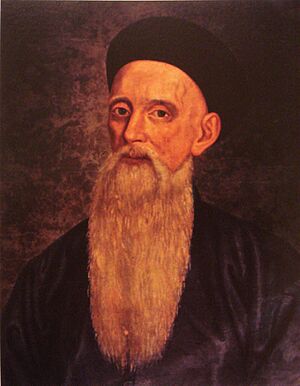
Qianlong gave Macartney a letter for the British king. In it, he explained why he would not grant Macartney's requests. He said China had everything it needed. He also said that allowing more trade ports would cause problems. He stated that China had its own moral system.
Macartney later wrote about his experience. He compared the Chinese Empire to an "old, crazy, first-rate Man of War." He meant it looked strong but was actually weak. He believed it would eventually fall apart if not led by a strong ruler.
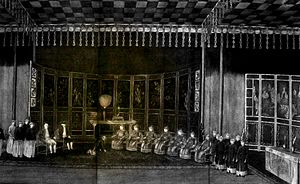
In 1795, a Dutch group also visited Qianlong's court. This was the last time Europeans met the Qing imperial court in the traditional way. The Dutch envoy, Isaac Titsingh, did perform the kowtow. Because of this, the Chinese treated him and his group very well.
Abdication and Death
In October 1795, the Qianlong Emperor announced he would step down in the spring of 1796. He had promised not to rule longer than his grandfather, the Kangxi Emperor. Kangxi had reigned for 61 years. Qianlong ruled for almost 61 years.
He planned to move out of the Hall of Mental Cultivation in the Forbidden City. This hall was only for the reigning emperor. In 1771, he started building a new home for his retirement. It was a lavish retreat called the Palace of Tranquil Longevity. It is also known as the "Qianlong Garden." This complex was finished in 1776.
Qianlong gave up the throne at age 85 to his son, the 36-year-old Jiaqing Emperor, in 1796. For the next three years, Qianlong held the title Taishang Huang (Emperor Emeritus). But he still held all the power. Jiaqing was emperor only in name. Qianlong never moved into his retirement home. He died in 1799.
Family of the Qianlong Emperor
Empress
- Empress Xiaoxianchun (孝賢純皇后) of the Fuca clan (富察氏; 1712–1748)
- First daughter (1728–1730)
- Yonglian (永璉), Crown Prince Duanhui (端慧皇太子; 1730–1738), second son
- Princess Hejing of the First Rank (固倫和敬公主; 1731–1792), third daughter
- Yongcong (永琮), Prince Zhe of the First Rank (哲親王; 1746–1748), seventh son
- Empress (皇后) of the Nara clan (那拉氏; 1718–1766)
- Yongji (永璂), Prince of the Third Rank (貝勒; 1752–1776), 12th son
- Fifth daughter (1753–1755)
- Yongjing (永璟; 1756–1757), 13th son
- Empress Xiaoyichun (孝儀純皇后) of the Weigiya clan (魏佳氏; 1727–1775)
- Princess Hejing of the First Rank (固倫和靜公主; 1756–1775), seventh daughter
- Yonglu (永璐; 1757–1760), 14th son
- Princess Heke of the Second Rank (和碩和恪公主; 1758–1780), ninth daughter
- Miscarriage (1759)
- Yongyan (永琰), the Jiaqing Emperor (嘉慶帝; 1760–1820), 15th son
- 16th son (1763–1765)
- Yonglin (永璘), Prince Qingxi of the First Rank (慶僖親王; 1766–1820), 17th son
Imperial Noble Consort
- Imperial Noble Consort Huixian (慧賢皇貴妃) of the Gaogiya clan (高佳氏; 1711–1745)
- Imperial Noble Consort Zhemin (哲憫皇貴妃) of the Fuca clan (富察氏; ?–1735)
- Yonghuang (永璜), Prince Ding'an of the First Rank (定安親王; 1728–1750), first son
- Second daughter (1731–1732)
- Imperial Noble Consort Shujia (淑嘉皇貴妃) of the Gingiya clan (金佳氏; 1713–1755)
- Yongcheng (永珹), Prince Lüduan of the First Rank (履端親王; 1739–1777), fourth son
- Yongxuan (永璇), Prince Yishen of the First Rank (仪慎亲王; 1746–1832), eighth son
- Yongyu (永瑜; 1748–1749), ninth son
- Yongxing (永瑆), Prince Chengzhe of the First Rank (成哲親王; 1752–1823), 11th son
- Imperial Noble Consort Chunhui (純惠皇貴妃) of the Su clan (蘇氏; 1713–1760)
- Yongzhang (永璋), Prince Xun of the Second Rank (循郡王; 1735–1760), third son
- Yongrong (永瑢), Prince Zhizhuang of the First Rank (質莊親王; 1744–1790), sixth son
- Princess Hejia of the Second Rank (和碩和嘉公主; 1745–1767), fourth daughter
- Imperial Noble Consort Qinggong (慶恭皇貴妃) of the Lu clan (陸氏; 1724–1774)
Noble Consort
- Noble Consort Xin (忻貴妃) of the Daigiya clan (戴佳氏; 1737–1764)
- Sixth daughter (1755–1758)
- Eighth daughter (1758–1767)
- Miscarriage (1764)
- Noble Consort Yu (愉貴妃) of the Keliyete clan (珂里葉特氏; 1714–1792)
- Yongqi (永琪), Prince Rongchun of the First Rank (榮純親王; 1741–1766), fifth son
- Noble Consort Xun (循貴妃) of the Irgen-Gioro clan (伊爾根覺羅氏; 1758–1798)
- Noble Consort Ying (穎貴妃) of the Baarin clan (巴鄰氏; 1731–1800)
- Noble Consort Wan (婉貴妃) of the Chen clan (陳氏; 1717–1807)
Consort
- Consort Shu (舒妃) of the Yehe-Nara clan (葉赫那拉; 1728–1777)
- Yongyue (永玥; 1751–1753), 10th son
- Consort Yu (豫妃) of the Oirat Borjigin clan (博爾濟吉特氏; 1730–1774)
- Miscarriage (1759 or 1760)
- Consort Rong (容妃) of the Hezhuo clan (和卓氏; 1734–1788)
- Consort Dun (惇妃) of the Wang clan (汪氏; 1746–1806)
- Princess Hexiao of the First Rank (固倫和孝公主; 1775–1823), 10th daughter
- Miscarriage (1777 or 1778)
- Consort Fang (芳妃) of the Chen clan (陳氏; ?–1801)
- Consort Jin (晉妃) of the Fuca clan (富察氏; ?–1822)
Concubine
- Concubine Yi (儀嬪) of the Huang clan (黄氏; ?–1736)
- Concubine Yi (怡嬪) of the Bo clan (柏氏; 1721–1757)
- Concubine Shen (慎嬪) of the Bai'ergesi clan (拜爾葛斯氏; ?–1765)
- Concubine Xun (恂嬪) of the Huoshuote clan (霍碩特氏; ?–1761)
- Concubine Cheng (誠嬪) of the Niohuru clan (鈕祜祿氏; ?–1784)
- Concubine Gong (恭嬪) of the Lin clan (林氏; 1733–1805)
Noble Lady
- Noble Lady Shun (順貴人) of the Niohuru clan (鈕祜祿氏; 1748–1790)
- Miscarriage (1776)
- Noble Lady E (鄂貴人) of the Sirin-Gioro clan (西林覺羅氏; ?–1808)
- Noble Lady Rui (瑞貴人) of the Socoro clan (索取羅氏; ?–1765)
- Noble Lady Bai (白貴人) of the Bo clan (柏氏; 1730–1803)
- Noble Lady Lu (祿貴人) of the Lu clan (陸氏; ?–1788)
- Noble Lady Shou (壽貴人) of the Bo clan (柏氏; ?–1809)
- Noble Lady Xiu (秀貴人; ?–1745)
- Noble Lady Shen (慎貴人; ?–1777)
- Noble Lady (贵人) of the Wu clan (武氏; ?–1781)
- Noble Lady Jin (金貴人; ?–1778)
- Noble Lady Xin (新貴人; ?–1775)
- Noble Lady Fu (福貴人; ?–1764)
First Class Attendant
- First Class Attendant Kui (揆常在; ?–1756)
- First Class Attendant Yu (裕常在) of the Zhang clan (张氏; ?–1745)
- First Class Attendant Ping (平常在; ?–1778)
- First Class Attendant Ning (寧常在; ?–1781)
Second Class Attendant
- Second Class Attendant Xiang (祥答应; ?–1773)
- Second Class Attendant Na (那答應)
- Second Class Attendant Wan (莞答應)
- Second Class Attendant Cai (采答應)
- Second Class Attendant (答應)
Mistress
- Mistress (格格; ?–1729)
- Mistress (格格; ?–1731)
Lady-in-waiting
- Lady-in-waiting (官女子)
Images for kids
-
A soldier from the Qianlong era, by William Alexander, 1793.
-
Emperor Qianlong, aged 65, in the Forbidden City, Beijing in 1761 (winter). 萬國來朝圖.
-
Qianlong Emperor entering Suzhou and the Grand Canal.
Error: no page names specified (help).
- Jean Joseph Marie Amiot
- Canton System
- Family tree of Chinese monarchs (late)
- Long Corridor
- Manwen Laodang
- Putuo Zongcheng Temple
- Qianlong Dynasty
- Qianlong Tongbao
- Portuguese Macau
- Military of Macau under Portuguese rule
- British Hong Kong
- British Forces Overseas Hong Kong
- Mao Zedong's cult of personality
- Macartney Embassy
- Liu Yong
- Heshen
See also
 In Spanish: Qianlong para niños
In Spanish: Qianlong para niños



